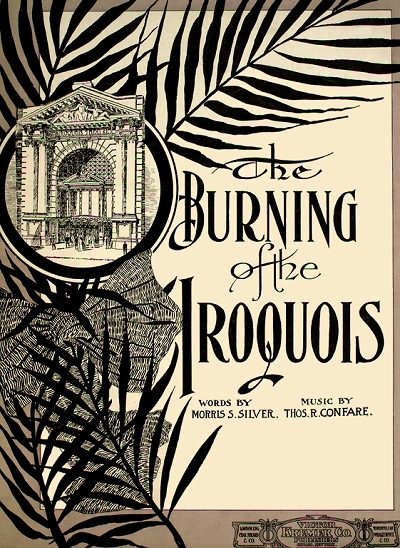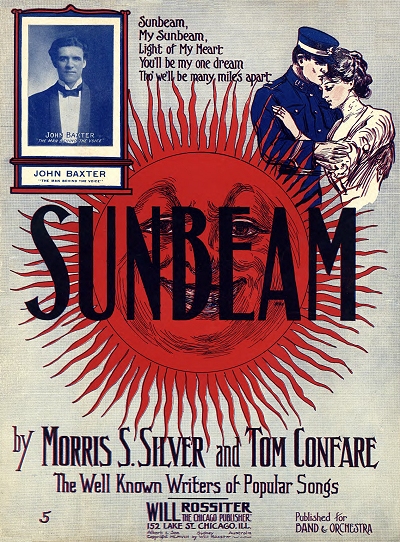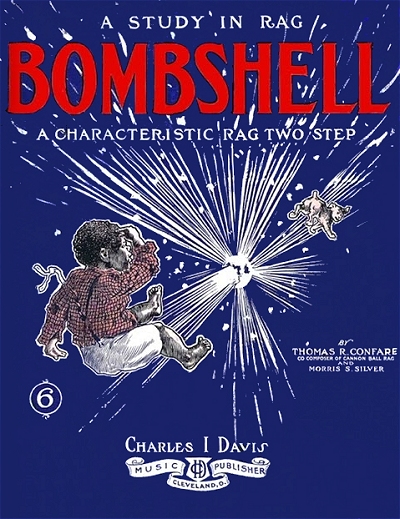 Thomas R. Confare (October 29, 1866 to January 6, 1943) | |
 Compositions Compositions | |
|
1895
Don't Leave Your Dear Old Southern Home [1]1896
You Never Know What Will Happen Till It’s O’erIllinois Cadet Two-Step 1903
American Conquest: March Two-StepI Could Learn to Love a Girl Just Like You [2] Amy [2] 1904
I Was Only Fooling (A Song Oddity) [2]Fighting for the Cause of Old Japan [2] The Burning of the Iroquois [2] South Haven's the Place for Me [2] Come Home Soldier Boy in Blue [2] They are Sleeping in the Land of Love Tonight [2] 1905
Not for Love [2]Carolina Dinah (I'se a-Waitin' Fo' You) [2,3] Love Me [2] A Sail in the Summertime (Sailing) [2] 1906
The Fate of San Francisco [2]The Blue Grass Shore [4] |
1907
I’ve Been Looking for a Girl Like You [2,5]Hail to the County Democracy [6] 1908
Slouchy SamSunbeam (Good-bye, Good-bye) [2] 1909
Bomb Shell: Characteristic Rag [2]1910
Southern Inspiration: March1913
Mooseheart: March and Two-Step1929
Dreams, Just Dreams [7]1936
Teach Me to Love [Unpub]
1. w/Barry Gray
2. w/Morris Silver 3. w/Joseph C. Northup 4. w/W.C. Piatt 5. w/Carter De Haven 6. w/Floyd D. Thompson 7. w/Don Fina |
 Selected Arrangements Selected Arrangements | |
|
The March of Union Labor [James C. Maloney] (1901)
Minnehaha: Dance Grotesque [Paul Loering] (1903) To the Front: March [William Baines] (1903) Let ‘er Go: March and Two-Step [G.E. Gallagher] (1904) Cannon Ball - A Characteristic Novelty [Joseph C. Northup] (1905) Just for Fun: Band Arr. [Hampton Durand & Morris Manley] (1905) Where the Sweet Arbutus Grows [J.H. Warner] (1905) I Want a Union Man [Hampton Durand & Morris S. Silver] (1905) On His Mother’s Grave He’s Sleeping [E. Piquet] (1907) The Old Church Bells [E. Piquet] (1907) Sunlight: An Indian Intermezzo [Harry L. Newman] (1908) The People’s Choice [Doc Murphy & Floyd Thompson] (1908) That Tuneful Rag [Buel B. Risinger] (1911) That Dahm Rag [Phil J. Dahm] (1912) The Camel Walk [Sam L. Rosenbaum & Joseph M. Verges] (1916) I Didn't Mean Goodbye [N.J. Clesi & Arthur Le Clerq] (1916) I'm From Chicago [Leo Edwards & Blanche Merrill] (1917) Tallahassee [Frank Bannister, Sam Gold & Dave Waters] (1924) Bobbed Head [Hampton Durand, Evans Lloyd, Herman Kahn] (1924) Roll Up Your Sleeves, Buddy Boy, and Let 'Em Have It [Morris Silver] (1942) | |
Thomas R. Confare was born to carpenter John M. Confare and his British wife Rosetta R. Each in Sabula, Iowa, just a short while after the Civil War had ended. He was one of five children born to the couple, including Mary M. (2/1854-1/1855), William Henry (3/19/1856) Katie Amelie (7/11/1865) and younger brother John George (9/5/1869). One other child, Harry Earl (11/1879) died at age two How much musical training Tom had while in school is uncertain. He was still in school as of 1880, but also working in a railroad office in Sabula, Iowa. George was now a wagon maker during a time of great expansion in the area. As of the 1885 Iowa census, Thomas appears in the family business as a carpenter, just short of 18 years old.
On October 22, 1890, Thomas married his first wife, Dorathie (Dorothy) Rosenstiel, and moved to the Boston, Massachusetts area for a while, perhaps to try and get a start in music as a career as that area was just a bit more active at that time than Chicago. On May 8, 1892 Dorothy gave birth to Thomas Newell. The couple had moved back to Chicago by 1895, where Confare's first three published songs appeared. For the 1900 enumeration, Confare was shown living in Chicago with his wife and child, and is listed as a musician, albeit unemployed for two months at that time. So, life was likely a bit hard, even in that bustling metropolis.
On May 8, 1892 Dorothy gave birth to Thomas Newell. The couple had moved back to Chicago by 1895, where Confare's first three published songs appeared. For the 1900 enumeration, Confare was shown living in Chicago with his wife and child, and is listed as a musician, albeit unemployed for two months at that time. So, life was likely a bit hard, even in that bustling metropolis.
 On May 8, 1892 Dorothy gave birth to Thomas Newell. The couple had moved back to Chicago by 1895, where Confare's first three published songs appeared. For the 1900 enumeration, Confare was shown living in Chicago with his wife and child, and is listed as a musician, albeit unemployed for two months at that time. So, life was likely a bit hard, even in that bustling metropolis.
On May 8, 1892 Dorothy gave birth to Thomas Newell. The couple had moved back to Chicago by 1895, where Confare's first three published songs appeared. For the 1900 enumeration, Confare was shown living in Chicago with his wife and child, and is listed as a musician, albeit unemployed for two months at that time. So, life was likely a bit hard, even in that bustling metropolis.That was the point when Confare likely decided to start working for publishers as a free-lance arranger, and as an orchestra and band director/arranger as well. One of his first credited arrangements was a union song released in 1901. As was likely the case, many of the arrangements, some of them perhaps just preparing a piece for typesetting, were not credited, so there are likely more. A second credit appears on a 1903 intermezzo, Minnehaha, part of the early surge of Indian-themed pieces.
Tom was divorced around this time, and in 1904 he was remarried to Clara Edith Hensey. Confare met Morris S. Silver, and the two started to click as a songwriting team in 1903. His work with Silver got Tom employed by publisher Victor Kremer at a time when Kremer's ragtime catalog was starting an impressive build-up. So, in addition to Confare/Silver songs, Tom's name appeared on other pieces as well. One of those was among the most famous and best-selling of the Kremer rags, Cannon Ball: A Characteristic Novelty, by Joseph C. Northup. The research on Northup shows that he was at least a fairly competent working musician, but apparently had minimal notation skills. It is probable that there was as much Confare in the rag arrangement as there was Northup. The end result was a moderately difficult but very pianistic score that was fun to both play and listen to. It also spread Confare's name prominently as it had Northup's.
It is probable that there was as much Confare in the rag arrangement as there was Northup. The end result was a moderately difficult but very pianistic score that was fun to both play and listen to. It also spread Confare's name prominently as it had Northup's.
 It is probable that there was as much Confare in the rag arrangement as there was Northup. The end result was a moderately difficult but very pianistic score that was fun to both play and listen to. It also spread Confare's name prominently as it had Northup's.
It is probable that there was as much Confare in the rag arrangement as there was Northup. The end result was a moderately difficult but very pianistic score that was fun to both play and listen to. It also spread Confare's name prominently as it had Northup's.Confare was shown to have created some band arrangements for Kremer from 1905 to 1908, but only a couple can be verified. He continued to write sporadically with Silver, but soon their output diminished to almost nothing. Two fine pieces appeared in 1908 - Sunbeam composed by Confare and Silver, and Sunlight: An Indian Intermezzo arranged by him. That same year saw the birth of his daughter Clara R. Confare, named after her mother.
In addition to composition and solo performance, Thomas was working for the 25 piece De Baugh band as their director. This was mentioned in a Chicago Tribune notice of February 1, 1908, which painted an unfortunate picture of bad behavior by a married man, tagging him as a "masher." Evidently Confare had forced his intentions on Miss Agnes Lang, a cashier in Arnold Brothers, a State Street restaurant. He pursued her outside, and after making a lewd pass she started to scream for the police while holding onto his coat to detain the perpetrator. After a brief chase by the police Confare was arrested and charged. A follow up on the disposition of this was not found other than a heavy court fine. Then a strange item appeared in The Music Trade Review of November 28, 1908:
Thomas Confare, the well-known musician, who has been doing the arranging for Harry Newmann, western representative of Harry Von Tilzer, passed away suddenly on Thursday of this week at his home in this city [Chicago].
Reports of his demise were obviously quite exaggerated and premature, but the underlying cause of this unfortunate mistake is unknown.
In 1909 Confare teamed once again with Silver to bring out Bomb Shell, more than just an obvious sequel to Cannon Ball. The similarity between the two rags, plus other examples of Confare's work, again suggests that he had a heavy hand in Cannon Ball. Bomb Shell did not sell anywhere nearly as well, but is still a very fine rag in its own right. While that was his last rag, two more arrangements with a Confare sound appeared in 1911 and 1912, That Tuneful Rag and That Dahm Rag. He was also working more steadily in Chicago theaters with the De Baugh Band and independently, and in the 1910 Census appeared in Chicago with wife Clara and daughter Clara, listed as a musician and director. His son, Thomas N. Confare, was also living with the family, and is listed as a music arranger in his own right. Kremer sold his catalog around this time to engage in other business, so Thomas had to search for employment elsewhere. In the interim, he got into a bit more trouble in 1911, underscoring some of the troubling traits that had dogged him three years prior, as noted in the Chicago Tribune of October 13:
While that was his last rag, two more arrangements with a Confare sound appeared in 1911 and 1912, That Tuneful Rag and That Dahm Rag. He was also working more steadily in Chicago theaters with the De Baugh Band and independently, and in the 1910 Census appeared in Chicago with wife Clara and daughter Clara, listed as a musician and director. His son, Thomas N. Confare, was also living with the family, and is listed as a music arranger in his own right. Kremer sold his catalog around this time to engage in other business, so Thomas had to search for employment elsewhere. In the interim, he got into a bit more trouble in 1911, underscoring some of the troubling traits that had dogged him three years prior, as noted in the Chicago Tribune of October 13:
 While that was his last rag, two more arrangements with a Confare sound appeared in 1911 and 1912, That Tuneful Rag and That Dahm Rag. He was also working more steadily in Chicago theaters with the De Baugh Band and independently, and in the 1910 Census appeared in Chicago with wife Clara and daughter Clara, listed as a musician and director. His son, Thomas N. Confare, was also living with the family, and is listed as a music arranger in his own right. Kremer sold his catalog around this time to engage in other business, so Thomas had to search for employment elsewhere. In the interim, he got into a bit more trouble in 1911, underscoring some of the troubling traits that had dogged him three years prior, as noted in the Chicago Tribune of October 13:
While that was his last rag, two more arrangements with a Confare sound appeared in 1911 and 1912, That Tuneful Rag and That Dahm Rag. He was also working more steadily in Chicago theaters with the De Baugh Band and independently, and in the 1910 Census appeared in Chicago with wife Clara and daughter Clara, listed as a musician and director. His son, Thomas N. Confare, was also living with the family, and is listed as a music arranger in his own right. Kremer sold his catalog around this time to engage in other business, so Thomas had to search for employment elsewhere. In the interim, he got into a bit more trouble in 1911, underscoring some of the troubling traits that had dogged him three years prior, as noted in the Chicago Tribune of October 13:Thomas Confare... a musician, was fined $100 and costs by Municipal Judge Caverly yesterday on a charge preferred by the Northwestern Elevated railroad that he had a habit of peeing at women through crevices in the Fullerton avenue platform.
Credited arrangements appear to have ceased for a while after 1912, but Tom was still working in theaters according to some Chicago sources. His third and last child, Edith, was born in 1912, taking her mother's middle name. There is not much available on him in the 1910s, but he moved west to the Chicago suburb of Winfield around the middle of the decade. Thomas N. showed up in the 1917 draft as a self-employed music printer, working in the famous Schiller Building above the Garrick Theater on West Randolph Street. A couple of arrangements by the elder Confare appeared under the Triangle Publishing moniker in New Orleans in 1916, but it seems unlikely he had moved there for even a short while, as a 1917 New York publication ironically titled "I'm From Chicago" also featured his name as arranger. Thomas was still established as a self-employed music director as of the 1920 census, living in Winfield with Clara E., and daughters Clara R. and Edith.
The 1920s were busy with music directing, but at least two more arrangements and one song appeared, with a few more likely not credited. Attempts to ascertain if Confare was with a group that was recorded at any point turned up empty, but even in Chicago with its many studios, this was not unusual. One final song composed with Buddy Fina appeared just at the cusp of the depression. As of 1930, the Confare family was still living at the same Winfield address, but 63-year-old Tom now listed himself as a music arranger, not a director, possibly because a number of steady hotel and theater gigs started to dry up around this time, and possibly because he was looking to retire. A decade later, still at the same Chicago address, Thomas, widowed and living with his daughters Clara and Edith, indeed showed no occupation. Interestingly, the last known piece released with Confare's name on it was a 1942 war song with attitude, Roll Up Your Sleeves, Buddy Boy, and Let 'Em Have It, composed by his old friend Silver and arranged (perhaps even enhanced) by Thomas. He passed away the following year at age 76, just a few years short of the ragtime revival in which Cannon Ball would play a starring role, and is buried in Evergreen Cemetery in Worth, Illinois.